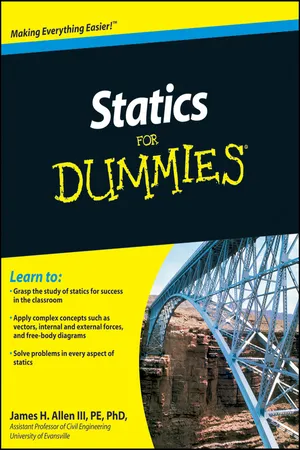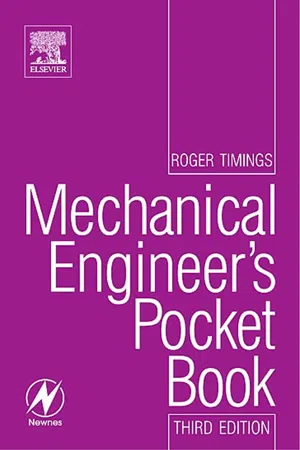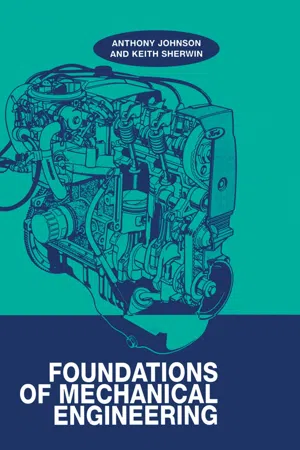Technology & Engineering
Statics
Statics is a branch of mechanics that deals with the study of objects at rest or in a state of equilibrium under the action of external forces. It focuses on analyzing the forces acting on structures and objects to determine their stability and balance. In engineering, statics is essential for designing and constructing stable and safe structures.
Written by Perlego with AI-assistance
Related key terms
6 Key excerpts on "Statics"
- eBook - ePub
- Ki Bang Lee(Author)
- 2011(Publication Date)
- Wiley-IEEE Press(Publisher)
CHAPTER 3 StaticsAs a branch of mechanics, Statics is concerned with force and moment on mechanical structures in static equilibrium. Using Statics, we can analyze forces and moments acting on mechanical structures and evaluate stress, defined as force per unit area, displacement, or deformation of a structural element. Structural elements are essential for MEMS since every component of a MEMS device consists of mechanical structures such as plates and flexures. For a desired function, mechanical structures must be stable and move properly.3.1 STATIC EQUILIBRIUMLet us consider a system that consists of an object subjected to forces and moments. If the system produces no motion, the system is in static equilibrium. For example, consider a rock that is placed on the ground as shown in Fig. 3.1 a. Since the gravitational force is an attractive force, the rock in Fig. 3.1 a weighs mg , where m and g denote the mass of the rock and the gravitational acceleration, defined as approximately 9.8 m/s2 on the surface of the Earth. As shown in Fig. 3.1 b, the weight mg , also known as the gravitational force , acts on the center of the rock and the ground generates a counterforce to support the rock. The counterforce N must be mg to maintain equilibrium. If a diagram like that of Fig. 3.1 b shows all external forces acting on an isolated body, the diagram is called a free -body diagram . Since the force is a vector quantity that is represented by its magnitude and direction, we can use the vector calculation to determine unknown forces. If an object is in equilibrium, the following force equilibrium condition must be satisfied:(3.1)where F 1 , F 2 , … , F n are the forces acting on the object.Figure 3.1 Rock in equilibrium.We can apply the force equilibrium condition to obtain the counterforce N in Fig. 3.1 b. The force equilibrium equation is given bywhere j is a unit vector parallel to the force mg - eBook - ePub
- James H. Allen(Author)
- 2010(Publication Date)
- For Dummies(Publisher)
Part I Setting the Stage for StaticsIn this part . . .This first part introduces you to the basic concepts of mechanics in engineering and the sciences, as well as the differences between the basic fields. You also pick up the basic assumptions you need when working Statics problems. I explain the two primary systems of units (U.S. customary and metric) and introduce you to the base units of each system. Finally, I review basic algebra, geometry, trigonometry, and calculus, all of which you encounter frequently in Statics.Passage contains an image
Chapter 1 Using Statics to Describe the World around You In This Chapter Defining Statics and related studies Introducing vectors Exploring free-body diagrams Looking at specific applications of StaticsStatics is a branch of physics that is especially useful in the fields of engineering and science. Although general physics may describe all the actions around you, from the waving of leaves on a tree to the reflection of light on a pond, the field of Statics is much more specific.In fact, Statics is actually a part of most physics courses. So if you’ve ever taken a high school or college physics course, chances are that some of the information in this book may seem vaguely familiar. For example, one of the first areas you study in physics is often Newtonian mechanics, which is basically Statics and dynamics.Physics classes typically cover a wide range of topics, basically because physics has a wide range of applications. Conversely, a Statics course is much more focused (which doesn’t necessarily mean it’s simple). Whoever said that the devil is in the details may well have been talking about Statics.Before you panic, close the book, and begin questioning why you ever thought you could understand Statics, let me reassure you that just because Statics isn’t always simple doesn’t mean it’s always difficult. If anything, Statics does happen to be very methodical. If you follow some basic steps and apply some basic ideas and theory, Statics actually can become a very straightforward application process. - eBook - ePub
- Godfrey Onwubolu(Author)
- 2014(Publication Date)
- ICP(Publisher)
PART 1
Statics
Passage contains an image
Chapter 1
Introduction
Objectives: When you complete this chapter you will have:• Understanding of the different areas of applied mechanics. • Understanding of how SolidWorks can be applied to the different areas of applied mechanics.Applied Mechanics
As a scientific discipline, applied mechanics derives many of its principles and methods from the physical sciences (in particular, mechanics and classical mechanics), from mathematics and, increasingly, from computer science. As such, applied mechanics shares similar methods, theories, and topics with applied physics, applied mathematics, and computer science.Applied mechanics, as its name suggests, bridges the gap between physical theory and its application to technology. As such, applied mechanics is used in many fields of engineering, especially mechanical engineering. In this context, it is commonly referred to as engineering mechanics. Much of modern engineering mechanics is based on Isaac Newton’s laws of motion while the modern practice of their application can be traced back to Stephen Timoshenko, who is said to be the father of modern engineering mechanics.Applied mechanics in engineering
Typically, engineering mechanics is used to analyze and predict the acceleration and deformation (both elastic and plastic) of objects under known forces (also called loads) or stresses.When treated as an area of study within a larger engineering curriculum, engineering mechanics can be subdivided into:•Statics, the study of non-moving bodies under known loads.•Dynamics, the study of how forces affect moving bodies.•Mechanics of materials or strength of materials, the study of how different materials deform under various types of stress.•Deformation mechanics, the study of deformations typically in the elastic range.•Fluid mechanics - eBook - ePub
- Roger Timings(Author)
- 2005(Publication Date)
- Newnes(Publisher)
2Engineering Statics
2.1 Engineering Statics
Engineering mechanics can be divided into Statics and dynamics . Basically, Statics is the study of forces and their effects in equilibrium, whereas dynamics is the study of objects in motion.2.2 Mass, force and weight
2.2.1 Mass
• Mass is the quantity of matter in a body. It is the sum total of the masses of all the subatomic particles in that body.• Matter occupies space and can be solid, liquid or gaseous.•Unless matter is added to or removed from a body, the mass of that body never varies. It is constant under all conditions. There are as many atoms in a kilogram of, say, metal on the moon as there are in the same kilogram of metal on planet Earth. However, that kilogram of metal will weigh less on the moon than on planet Earth (see Section 2.2.4 ).•The basic unit of mass is the kilogram (kg). The most commonly used multiple of this basic unit is the tonne (1000 kg) and the most commonly used sub-multiple is the gram (0.001 kg).2.2.2 Force
To understand how mass and weight are related it is necessary to consider the concept of force . A force or a system of forces cannot be seen; only the effect of a force or a system of forces can be seen. That is:• A force can change or try to change the shape of an object.•A force can move or try to move a body that is at rest. If the magnitude of the force is sufficiently great it will cause the body to move in the direction of the application of the force. If the force is of insufficient magnitude to overcome the resistance to movement it will still try to move the body, albeit unsuccessfully.• A force can change or try to change the motion of a body that is already moving. For example: - eBook - ePub
- A. D. Johnson(Author)
- 2017(Publication Date)
- CRC Press(Publisher)
Statics 44.1 AIMS
- To introduce forces and their application.
- To describe the types of force which may be encountered.
- To explain how forces and force systems may be analysed using vectors.
- To introduce the concept of equilibrium.
- To show how the concept of equilibrium can be used to analyse force systems containing two or more forces.
- To explain how forces acting on bodies or systems create moments and couples.
4.2 Statics
Statics is the analysis of stationary objects under the influence of forces of various types. From Newton’s first law of motion a body can remain stationary only if there is no force acting on the body. Alternatively, if there are several forces which balance each other, the body is in equilibrium and remains stationary. It is necessary to define the types of forces which may be encountered and examine the ways in which they may be analysed.4.2.1 Applied forces
Applied forces are applied from an external source, such as when a block is suspended by a rope. The upward force in the rope is the applied force on the block, as shown in Figure 4.1(a) . If the applied force due to the rope did not exist, the block would simply fall under the action of gravity.4.2.2 Reactive forces
Newton’s third law says that for every applied force there is a reactive force present. In Figure 4.1(b) the reactive force is the force induced in the rope by the weight of the block. Applied forces and reactive forces always act in pairs. One cannot exist without the other. They always act along the same line and in opposite directions.Fig. 4.1 Suspended block showing (a) external forces, (b) reactive forces.4.2.3 Internal forces
Internal forces are the equal and opposite reactions to the externally applied loads. In Figure 4.2(a) the external forces are those which are applied by the weight of the trap-door to the cable and by the bracket to the cable. The internal forces lie within the cable and are the same magnitude as the external forces but act in the opposite direction, as shown in the free-body diagram in Figure 4.2(b) - eBook - ePub
- James L. Meriam, L. G. Kraige, J. N. Bolton(Authors)
- 2018(Publication Date)
- Wiley(Publisher)
Mechanics is the oldest of the physical sciences. The early history of this subject is synonymous with the very beginnings of engineering. The earliest recorded writings in mechanics are those of Archimedes (287–212 B.C.) on the principle of the lever and the principle of buoyancy. Substantial progress came later with the formulation of the laws of vector combination of forces by Stevinus (1548–1620), who also formulated most of the principles of Statics. The first investigation of a dynamics problem is credited to Galileo (1564–1642) for his experiments with falling stones. The accurate formulation of the laws of motion, as well as the law of gravitation, was made by Newton (1642–1727), who also conceived the idea of the infinitesimal in mathematical analysis. Substantial contributions to the development of mechanics were also made by da Vinci, Varignon, Euler, D'Alembert, Lagrange, Laplace, and others.Sir Isaac NewtonIn this book we will be concerned with both the development of the principles of mechanics and their application. The principles of mechanics as a science are rigorously expressed by mathematics, and thus mathematics plays an important role in the application of these principles to the solution of practical problems.The subject of mechanics is logically divided into two parts: Statics , which concerns the equilibrium of bodies under action of forces, and dynamics , which concerns the motion of bodies. Engineering Mechanics is divided into these two parts, Vol. 1 Statics and Vol. 2 Dynamics.1/2 Basic Concepts
The following concepts and definitions are basic to the study of mechanics, and they should be understood at the outset.Space is the geometric region occupied by bodies whose positions are described by linear and angular measurements relative to a coordinate system. For three-dimensional problems, three independent coordinates are needed. For two-dimensional problems, only two coordinates are required.Time is the measure of the succession of events and is a basic quantity in dynamics. Time is not directly involved in the analysis of Statics problems.Mass is a measure of the inertia of a body, which is its resistance to a change of velocity. Mass can also be thought of as the quantity of matter in a body. The mass of a body affects the gravitational attraction force between it and other bodies. This force appears in many applications in Statics.Force is the action of one body on another. A force tends to move a body in the direction of its action. The action of a force is characterized by its magnitude, by the direction of its action, and by its point of application. Thus force is a vector quantity, and its properties are discussed in detail in Chapter 2 .A particle
Index pages curate the most relevant extracts from our library of academic textbooks. They’ve been created using an in-house natural language model (NLM), each adding context and meaning to key research topics.





